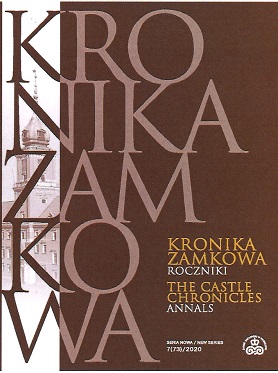Kunstkamera „Gabinet sztuki królewicza Władysława Zygmunta Wazy” i jej antwerpskie konotacje.
The Kunstkammer Prince Ladislaus Sigismund Vasa's Art Cabinet and its Antwerp connotations.
Author(s): Agnieszka PudlisSubject(s): Fine Arts / Performing Arts, Cultural history, History of Art
Published by: Arx Regia® Wydawnictwo Zamku Królewskiego w Warszawie – Muzeum
Keywords: Kunstkammer; Ladislaus IV Vasa; Preziosenwand; history of collecting; dramma per musica; Chinese export porcelain; Frans Francken II (the Younger)
Summary/Abstract: The painting Prince Ladislaus Sigismund Vasa’s Art Cabinet, created in 1626 in Warsaw, belongs to a small group of paintings depicting idealised or real art collections called Kunstkammern. The author of the article determines the specific features of the composition scheme of the title painting and juxtaposes this type of still life with similar paintings made in the first half of the seventeen century. It turns out that the closest analogies should be sought in the paintings by Frans Francken the Younger, active in Antwerp. The author argues that it is right to use methods drawn from the theory of literature (the theory of intertextuality) and logical semiotics in the studyof the painting. These methods enable us to assume that all presented objects (also Chinese porcelain plates, flowers, skulls, and ships – shown in other ‘pictures in the picture’ – i.e. quotes in the quote) could be included in the same set of the (virtual) collection of the Polish prince. Next, the author juxtaposes various hypotheses regarding the image of the architectural element en grisaille, visible in the upper right part of the painting. If it is not, as previously suggested by scholars, a fragment of the scenery for a dramma per musica, then perhaps it is the design of the theatre building itself, created in the spirit of the Palladian reception of Vitruvius, or a reminiscence from the era of one of the graphics illustrating architectural treatises or reconstructions of Roman buildings. This element resembles very much the frons scenae of the Teatro Olimpico in Vicenza. Thus, it is also related to the academic theatre, often presented in opposition – due to the philology of architecture – to the court theatre of that time. The comparison of various Kunstkammern of the period in the Preziosenwand (Wall-of- -Treasure) type helps to understand the message of the Warsaw painting, which still leaves much room for research, but is undoubtedly a kind of psychological portrait of the future ruler and the illustration his cultural and political ambitions.
Journal: Kronika Zamkowa. Roczniki
- Issue Year: 7/2020
- Issue No: 7
- Page Range: 35-58
- Page Count: 23
- Language: Polish

